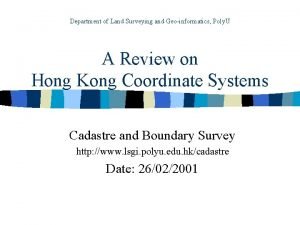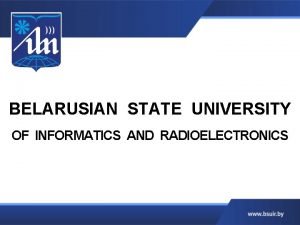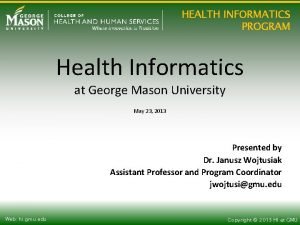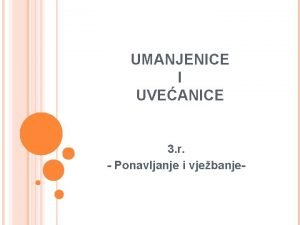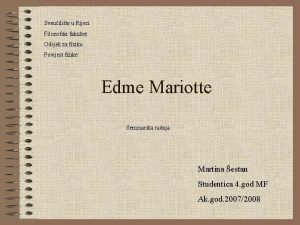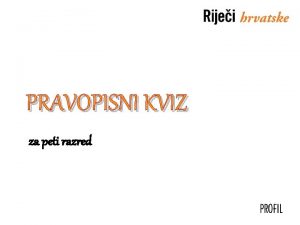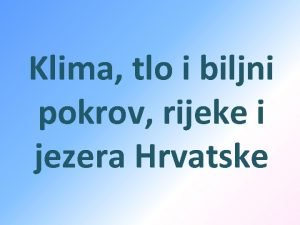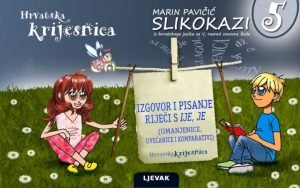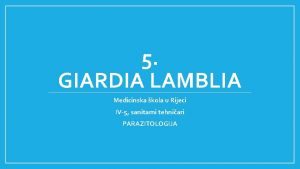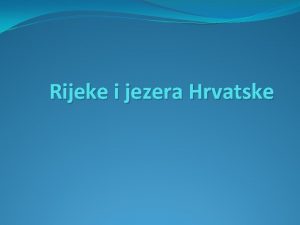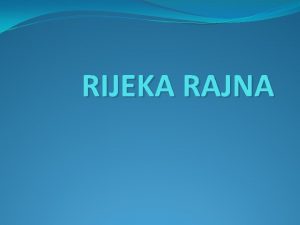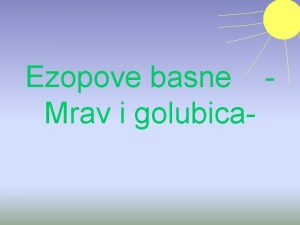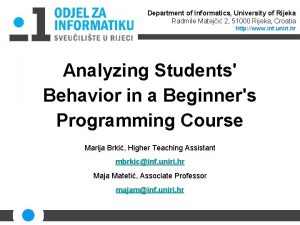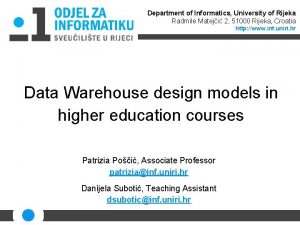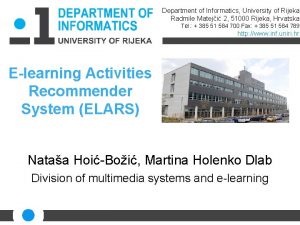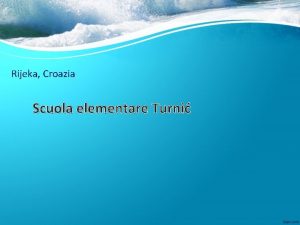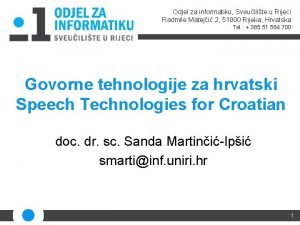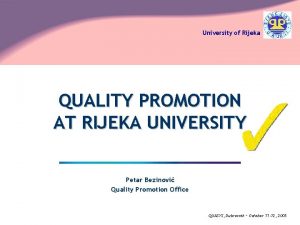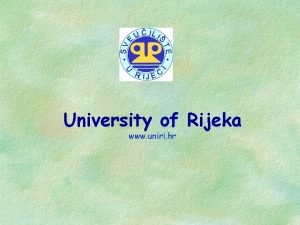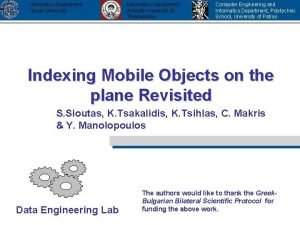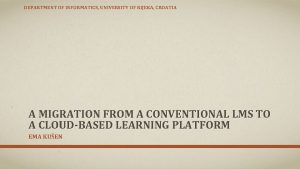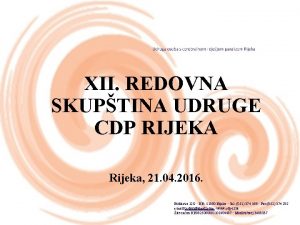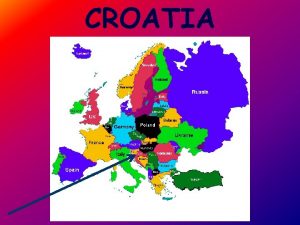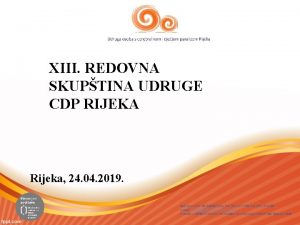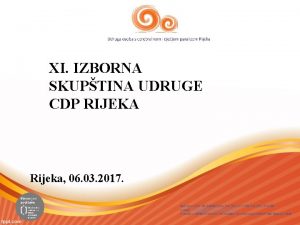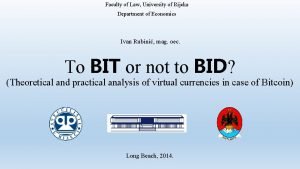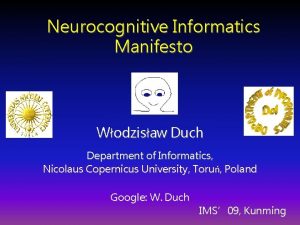Department of Informatics University of Rijeka Radmile Mateji





















- Slides: 21

Department of Informatics, University of Rijeka Radmile Matejčić 2, 51000 Rijeka, Croatia http: //www. inf. uniri. hr Teaching management and business communication to future IT experts Patrizia Poščić, Assistant Professor patrizia@inf. uniri. hr Danijela Subotić, Teaching Assistant dsubotic@inf. uniri. hr

The presentation is about • Teaching management and business communication skills and techniques to graduate (master) students at the Department of Informatics • Management and Leadership course • Business Communication course 2

Management and Leadership • The course is held on the second year of graduate (master) program • The course consists of theoretical lectures and practical exercises 3

Management and Leadership • In the lectures students can learn: – Organization Theory – Entrepreneurship and Competition – Planning – Strategic, Tactical and Operational Management – Human Resource Management and Performance monitoring – Total Quality Management – SWOT analysis 4

Management and Leadership • In the lectures students can learn: – Crysis Management (methods to solve problems) – Decision-making process, deciding factors and team decisionmaking – Use of information systems as a basis for decision-making and management – Project Management and IT Support – Safety and risks – Time Management – Virtual organizations 5

Management and Leadership • In the practical exercises students can learn: – Game Theory – Strategic Planning – Time Management – HRM software analysis – Motivation and Creativity 6

Management and Leadership (exercises) • Game theory deals with situations of conflict between two or more participants and focuses on strategic interactive decision-making • The goal of game theory is not to win, but to find an optimal strategy that will maximize payoff/profit • Game theory is based on mathematical principles – students can develop systematic way of thinking and approaching to problem solving • Students can learn to collect information in order to plan and strategize their behavior and to consider all perspectives and possible outcomes of specific situaction, in order to make a better decision 7

Management and Leadership (exercises) • Prisoners dilemma Poreći Priznati Poreći 0 0 20 0 Priznati 0 20 10 10 • Market monopoly 8

Management and Leadership • Strategic planning - development of a strategic plan for the period 3 -5 years • Vision, mission, values, SWOT analysis, general and specific goals, priorities, influences, teamwork • IT support to strategic planning and execution – MS Project (project plan and gantogram, objectives and activities tree, activity implementation table, cost-benefit analysis, monitoring table) 9

10

Management and Leadership (exercises) • Human resource management (HRM) software analysis • Next academic year – practical exercises in some open-source ERP software (Open. ERP, Web. ERP, . . . ) 11

Business Communication • The course is also held on the second year of graduate (master) program • The course consists of theoretical lectures (mostly online) and practical exercises (organized in a form of mini-workshops) • The emphasis is on practical exercises during which students can practice and adopt various communication skills 12

Business Communication • In the lectures students can learn: – Effective communication: Components and process. Types of communication. Communication barriers. Cultural influences. – Verbal Communication: Language. Meaning. Clarity of expression. Formality of language. – Nonverbal communication: Types of nonverbal communication. Functions. Nonverbal expressiveness and sensitivity. Discrepancy between verbal and nonverbal communication. Selfpresentation. – Teamwork 13

Business Communication • In the lectures students can learn: – Communication skills: • Listening. The importance of listening. Components. Active listening techniques. • Conflict and Negotiation. Types of conflict. Causes of conflict. The consequences of the conflict. Conflict resolution. • Assertiveness. What is assertiveness? Specific techniques of assertive behavior. • Public communication: The purpose of speech. Organizing speech. The presentation speech. 14

Business Communication • In the practical exercises (workshops) students can learn: – Verbal and Nonverbal Communication – Business Correspondence – Conducting and Participating in Meetings – Job Interviews – Telephone Communication – Presentation and Promotion - Public Appearances – Sales skills and Negotiation – Marketing Practices 15

Business Communication (exercises) • All students except one leave the classrom until they are called in. One student that is left in the classroom has to read the given story, and narrate it to the first student that comes back, then the second student has to narrate the story that he heard to the third student, etc. The goal of this exercise is to demonstrate how little we listen, and how easy is to loose information in a conversation 16

17

18

19

Conclusion • Introduce students to business theory and practice • Emphasis on the relationship between business and technology • IT in support of business communication and management 20

Thank You for your attention!
 Hong kong 1980 grid system
Hong kong 1980 grid system Belarusian university of informatics and radioelectronics
Belarusian university of informatics and radioelectronics Health informatics gmu
Health informatics gmu Vrste karti
Vrste karti Noga umanjenica
Noga umanjenica Fakultet za fiziku rijeka
Fakultet za fiziku rijeka Rijeka nil
Rijeka nil Rečenični dijelovi kviz
Rečenični dijelovi kviz Najprometnija europska rijeka
Najprometnija europska rijeka Gorska hrvatska tlo
Gorska hrvatska tlo Komparacija pridjeva vrijedan
Komparacija pridjeva vrijedan Rijeka population
Rijeka population Giardoza
Giardoza Hrvatske rijeke koje pripadaju crnomorskom slijevu
Hrvatske rijeke koje pripadaju crnomorskom slijevu Volga rijeka
Volga rijeka Najveća europska rijeka
Najveća europska rijeka Tunai rijeka
Tunai rijeka Granična rijeka prema sloveniji
Granična rijeka prema sloveniji Srednja škola andrije ljudevita adamića rijeka cijena
Srednja škola andrije ljudevita adamića rijeka cijena Rijeka glibuša
Rijeka glibuša Department of law university of jammu
Department of law university of jammu Department of geology university of dhaka
Department of geology university of dhaka
